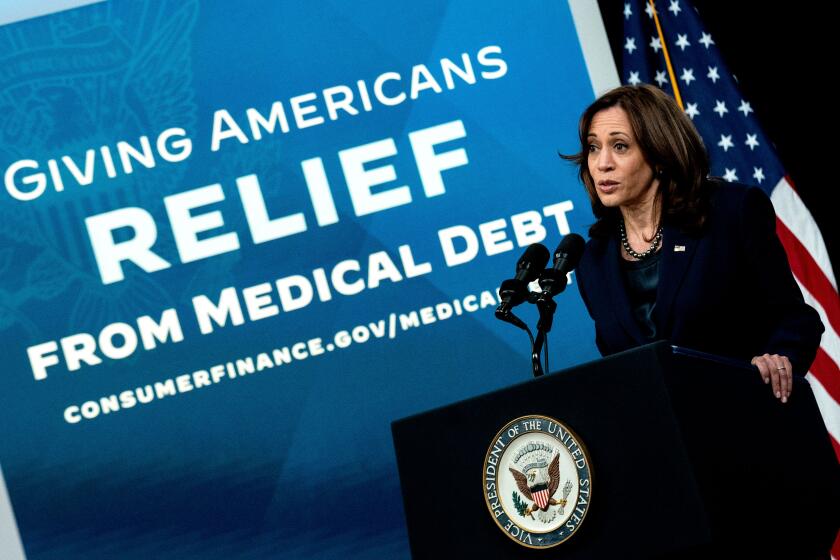Medical debt is disappearing from Americans’ credit reports, lifting scores

- Share via
The share of American consumers with medical debt on their credit reports has declined dramatically over the last year as major credit rating agencies removed small unpaid bills and debts that were less than a year old, according to a new analysis from the nonprofit Urban Institute.
At the same time, millions of Americans have seen their credit scores improve, making it easier for many to get a job, rent an apartment or get a car.
“This is a very significant change,” said Breno Braga, an economist at the Urban Institute and a co-author of the study. “It affects a lot of people.”
The analysis found that, as of August, just 5% of adults with a credit report had a medical debt on their report, down from almost 14% two years earlier.
Urban Institute researchers also found that Americans with a medical debt on their credit report in August 2022 saw their VantageScore credit score improve over the next year from an average of 585 to an average of 615.
That moved many consumers out of the subprime category. Subprime borrowers typically pay higher interest rates on loans and credit cards, if they can borrow at all.
About 20% of U.S. households are grappling with some form of medical debt. Federal officials are fashioning a rule to keep it out of credit reports.
Consumers’ improved scores don’t mean the medical debts have been eliminated. Hospitals, collectors and other medical providers still pursue patients for unpaid bills. And many continue to sue patients, place liens on their homes or sell their debts. But the credit reporting changes appear to be mitigating one of the more pernicious effects of medical debt that for years has undermined the financial security of tens of millions of patients and their families.
Credit scores depressed by medical debt, for example, can threaten people’s access to housing and fuel homelessness.
In total, about 27 million people experienced a significant improvement in their score, the Urban Institute researchers estimated. VantageScore, which uses a slightly different methodology than FICO, in January stopped using any medical debt to calculate scores.
The credit reporting changes have drawn criticism from debt collectors and some medical providers, who warn that hospitals and physicians may require upfront payments from patients before delivering care or may push more patients into credit cards and other kinds of loans.
In August, a California dermatologist sued the three major consumer credit rating agencies, saying that with fewer medical debts appearing on credit reports, patients would have less of an incentive to pay their bills, costing physicians nationwide potentially billions of dollars. The case is pending in federal court.
“Diagnosis: Debt” is a reporting partnership between KFF Health News and NPR exploring the scale, impact, and causes of medical debt in America.
But most leading consumer and patient advocates applaud the more restrictive credit reporting rules. Other research, by the federal Consumer Financial Protection Bureau, has found that medical debt — unlike other kinds of debt — does not accurately predict a consumer’s creditworthiness, calling into question how useful it is on a credit report.
In September, the Biden administration announced plans to push broader changes that would eliminate all medical debts from consumers’ credit scores. Federal regulations to implement such a ban will be developed next year by the CFPB, federal officials said.
This would expand current state efforts. In June, Colorado enacted a trailblazing bill that prohibits medical debt from being included on residents’ credit reports or factored into their credit scores. A similar measure was passed by the New York state legislature this year and is pending before the governor.
One in 10 residents in Los Angeles County are burdened by medical debt. And the uninsured aren’t the only ones vulnerable to debilitating health bills.
The Urban Institute researchers predicted that these policies would continue to improve consumer credit scores, though they warned that more systemic changes will be necessary to reduce medical debt, which burdens about 100 million people in the U.S.
“Reducing the burden of medical debt and its wide-ranging consequences would likely require health insurance reforms that build on the Affordable Care Act to further protect consumers from out-of-pocket medical expenses they can’t afford,” the report concludes.
The report by the Urban Institute, which has worked with KFF Health News over the last two years to analyze medical debt data, is based on a sample of credit records from one of the three large credit rating agencies.
KFF Health News, formerly known as Kaiser Health News, is a national newsroom that produces in-depth journalism about health issues and is one of the core operating programs at KFF — the independent source for health policy research, polling and journalism.
More to Read
Inside the business of entertainment
The Wide Shot brings you news, analysis and insights on everything from streaming wars to production — and what it all means for the future.
You may occasionally receive promotional content from the Los Angeles Times.












